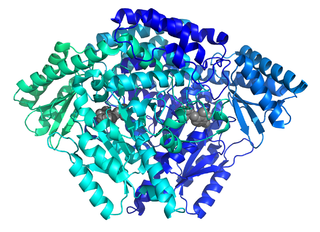Interferon alpha-1/13, also known as IFN-alpha-1/13, is a protein that in humans is encoded by the IFNA1 and IFNA13 genes. [3] [4]
Interferon alpha-1/13, also known as IFN-alpha-1/13, is a protein that in humans is encoded by the IFNA1 and IFNA13 genes. [3] [4]

Interferons are a group of signaling proteins made and released by host cells in response to the presence of several viruses. In a typical scenario, a virus-infected cell will release interferons causing nearby cells to heighten their anti-viral defenses.

The enzyme histidine decarboxylase is transcribed on chromosome 15, region q21.1-21.2, and catalyzes the decarboxylation of histidine to form histamine. In mammals, histamine is an important biogenic amine with regulatory roles in neurotransmission, gastric acid secretion and immune response. Histidine decarboxylase is the sole member of the histamine synthesis pathway, producing histamine in a one-step reaction. Histamine cannot be generated by any other known enzyme. HDC is therefore the primary source of histamine in most mammals and eukaryotes. The enzyme employs a pyridoxal 5'-phosphate (PLP) cofactor, in similarity to many amino acid decarboxylases. Eukaryotes, as well as gram-negative bacteria share a common HDC, while gram-positive bacteria employ an evolutionarily unrelated pyruvoyl-dependent HDC. In humans, histidine decarboxylase is encoded by the HDC gene.

Interleukin-26 (IL-26) is a protein that in humans is encoded by the IL26 gene.

Interleukin-22 (IL-22) is protein that in humans is encoded by the IL22 gene.

Interferon regulatory factor 3, also known as IRF3, is an interferon regulatory factor.

Signal transducer and activator of transcription 2 is a protein that in humans is encoded by the STAT2 gene. It is a member of the STAT protein family. This protein is critical to the biological response of type I interferons (IFNs). STAT2 sequence identity between mouse and human is only 68%.

Interferon beta is a protein that in humans is encoded by the IFNB1 gene. The natural and recombinant protein forms have antiviral, antibacterial, and anticancer properties.
Interferon alfa-2b is an antiviral or antineoplastic drug. It is a recombinant form of the protein Interferon alpha-2 that was originally sequenced and produced recombinantly in E. coli in the laboratory of Charles Weissmann at the University of Zurich, in 1980. It was developed at Biogen, and ultimately marketed by Schering-Plough under the trade name Intron-A. It was also produced in 1986 in recombinant human form, in the Center for Genetic Engineering and Biotechnology of Havana, Cuba, under the name Heberon Alfa R.

Interferon alpha-2 is a protein that in humans is encoded by the IFNA2 gene.

Interferon-induced transmembrane protein 1 is a protein that in humans is encoded by the IFITM1 gene. IFITM1 has also recently been designated CD225. This protein has several additional names: fragilis, IFI17 [interferon-induced protein 17], 9-27 [Interferon-inducible protein 9-27] and Leu13.

Interferon alpha-17 is a protein that in humans is encoded by the IFNA17 gene.

Interferon alpha-14 is a protein that in humans is encoded by the IFNA14 gene.

Interferon alpha-8 is a protein that in humans is encoded by the IFNA8 gene.

Interferon alpha-10 is a protein that in humans is encoded by the IFNA10 gene.
Interferon, type 1, cluster, also known as IFN1@, is a human gene.

Interferon alpha-5 is a protein that in humans is encoded by the IFNA5 gene.

Interferon alpha-21 is a protein that in humans is encoded by the IFNA21 gene.

Interferon alpha-6 is a protein that in humans is encoded by the IFNA6 gene.

Interferon alpha-16, also known as IFN-alpha-16, is a protein that in humans is encoded by theIFNA16 gene.

Interferon lambda 3 encodes the IFNL3 protein. IFNL3 was formerly named IL28B, but the Human Genome Organization Gene Nomenclature Committee renamed this gene in 2013 while assigning a name to the then newly discovered IFNL4 gene. Together with IFNL1 and IFNL2, these genes lie in a cluster on chromosomal region 19q13. IFNL3 shares ~96% amino-acid identity with IFNL2, ~80% identity with IFNL1 and ~30% identity with IFNL4.
IFNA13 is an interferon gene.